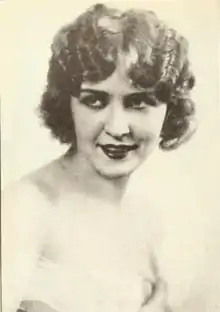Mary Eaton
Mary Eaton (January 29, 1901 – October 10, 1948) was an American stage actress, singer, and dancer in the 1910s and 1920s, probably best known today from her appearance in the first Marx Brothers film The Cocoanuts (1929). A professional performer since childhood, she enjoyed success in stage productions such as the Ziegfeld Follies. She appeared in another early sound film Glorifying the American Girl (1929). Her career declined sharply during the 1930s and a battle with alcoholism led to her death in October 1948 from cirrhosis at the age of 47.
Mary Eaton | |
|---|---|
 | |
| Born | Mary Eaton January 29, 1901 Norfolk, Virginia, U.S. |
| Died | October 10, 1948 (aged 47) Hollywood, California, U.S. |
| Other names | Actress, singer, dancer |
| Years active | 1916–1932; 1942 |
| Spouse(s) | Charles A. Emery
(m. 1937; div. 1942)[1] |
Biography
Early life and career
Eaton, a native of Norfolk, Virginia, began attending dance lessons in Washington, DC, along with her sisters Doris and Pearl, at the age of seven. In 1911, all three sisters were hired for a production of Maurice Maeterlinck's fantasy play The Blue Bird at the Shubert Belasco Theatre in Washington, D.C. While Eaton had a minor role in the show, it marked the beginning of her career in professional theatre.
After The Blue Bird ended, in 1912, the three Eaton sisters and their younger brother Joe began appearing in various plays and melodramas for the Poli stock company. They quickly gained reputations as professional, reliable, and versatile actors, and were rarely out of work. A 1914 newspaper article described Mary Eaton as "the newest and littlest member of the company", adding that she had "admirable poise and grace."[2]
In 1915, all three sisters appeared in a new production of The Blue Bird for Poli; Doris and Mary were given the starring roles of Mytyl and Tytyl. The siblings then were invited to reprise their roles for a New York and road tour of the play, produced by the Shubert Brothers. When the show closed, on the recommendation of the Shuberts, Mary began studying ballet in earnest with Theodore Kosloff.
Professional theatre

Of all of the Eatons, Mary was perhaps the most famous and the most popular. An exceptionally talented dancer, she earned raves in a production of Intime in Washington, DC in 1917.
In 1916, she made her Broadway debut, dancing a ballet specialty in Follow Me.[3] The next year, she performed in the Shubert Brothers' Over the Top with Fred and Adele Astaire. Throughout the 1920s, Eaton was a constant presence on Broadway, appearing in eight different productions.
She was featured in three editions of the Ziegfeld Follies, those of 1920, 1921, and 1922.[4] Eaton's trademark dance routine, which she performed in the Follies, involved a complicated sequence of pirouettes around the stage en pointe.
Film career
Eaton also had a brief film career, appearing in two important early sound movies that were filmed in New York. She was the ingenue in The Cocoanuts (1929) with the Marx Brothers. Glorifying the American Girl (1929), which included a brief Technicolor sequence, was produced by Flo Ziegfeld and included a cast of stage notables. Eaton's singing and dancing routines, including her signature pirouette sequence, were featured. The film's commercial failure, however, signaled the end of Eaton's starring career in sound movies. Her speaking voice on film was a carefully affected, high-pitched twitter that enunciated dialogue carefully, probably a remnant of her stage training. Her actual speaking voice, without the affectation and in a lower, more realistic range, can be heard briefly in Glorifying the American Girl.
Personal life
Many of the Eaton siblings, including Mary, found their careers waning in the early 1930s. She made her final stage appearance in 1932. Beset by career woes and three consecutive difficult marriages, Eaton struggled with alcoholism. Although her siblings tried to intervene on numerous occasions, and she entered rehabilitation programs several times, she was unable to overcome her alcohol addiction.
Eaton married Millard Webb (her director of Glorifying the American Girl) in the summer of 1929.[5] At the time of her death she was married to actor Eddie Laughton.
Eaton died at age 47 in Hollywood, California.[6] She was buried in Forest Lawn Cemetery in Los Angeles alongside other members of the Eaton family.
Filmography
| Year | Title | Role | Notes |
|---|---|---|---|
| 1923 | His Children's Children | Mercedes | |
| 1924 | Broadway After Dark | Herself, cameo appearance | |
| 1929 | A Ziegfeld Midnight Frolic | Herself | short |
| 1929 | The Cocoanuts | Polly Potter | |
| 1929 | Glorifying the American Girl | Gloria Hughes | |
| 1942 | We'll Smile Again | Continuity Girl | British Uncredited, (final film role) |
References
- "Mary Eaton Wed Here to Long-Time Admirer". The Los Angeles Times. Los Angeles, California. October 17, 1944. p. 13.
- "Poli's". The Washington Herald. D.C, Washington. February 17, 1914. p. 7. Retrieved March 11, 2018 – via Newspapers.com.

- "Mary Eaton". Internet Broadway Database. The Broadway League. Archived from the original on March 12, 2018. Retrieved March 12, 2018.
- Slide, Anthony (2012). The Encyclopedia of Vaudeville. Univ. Press of Mississippi. p. 572. ISBN 9781617032509. Retrieved March 12, 2018.
- Abrams, Brett L. (2008). Hollywood Bohemians: Transgressive Sexuality and the Selling of the Movieland Dream. McFarland. p. 89. ISBN 9780786439294. Retrieved March 12, 2018.
- "Famous Danseuse Of Ziegfeld Follies Dies". The News-Review. Oregon, Roseburg. Associated Press. October 14, 1948. p. 8. Retrieved March 11, 2018 – via Newspapers.com.

- Travis, Doris Eaton. The Days We Danced, Marquand Books, 2003, ISBN 0-8061-9950-4
External links
| Wikimedia Commons has media related to Mary Eaton. |
- Mary Eaton at the Internet Broadway Database

- Mary Eaton at IMDb
- Mary Eaton at Find a Grave
